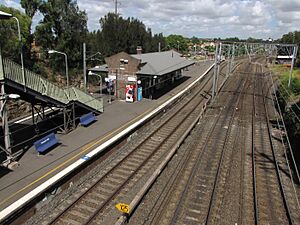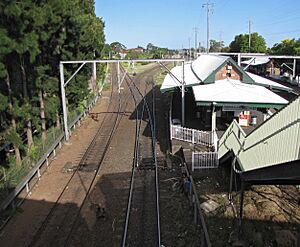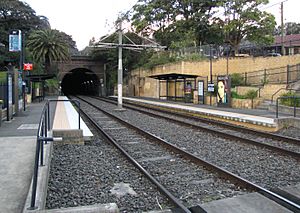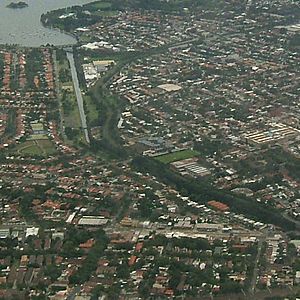Sydney Freight Network facts for kids
Quick facts for kids Sydney Freight Network |
|
|---|---|
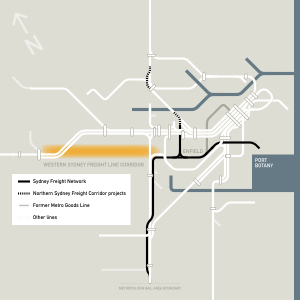
New South Wales Metropolitan Rail Area with Sydney Freight network highlighted in black.
|
The Sydney Freight Network is a special set of railway lines in Sydney, Australia. These lines are only for moving freight, which means they carry goods and products, not people. This network connects the railway lines from other parts of the state and country to Sydney's main freight yard at Enfield. It also links to Port Botany, a very important seaport.
The main parts of this network are the Southern Sydney Freight Line (SSFL) and a line that goes from Sefton to Enfield and then to Port Botany. Since 2012, the Australian Rail Track Corporation (ARTC) has been in charge of managing this network. Before the SSFL was finished, it was called the Metropolitan Freight Network and was managed by RailCorp.
Contents
How the Freight Lines Work
The Sydney Freight Network has different starting points. One part begins near the Flemington Maintenance Depot. Another part starts at Sefton. Both of these lines meet up at Enfield. Freight trains coming from the north and west of the state use the Flemington line. Trains from the south use the Sefton line.
From Enfield, the freight line goes south towards Campsie. Then, it turns east and runs next to the Bankstown passenger train line until it reaches Marrickville. At Marrickville, there's a connection to the Illawarra line. This link allows freight to reach a sea terminal at Port Kembla, which is south of Sydney. After Marrickville, the freight line continues on its own path to the Cooks River and Port Botany container terminals.
There used to be another line called the Rozelle–Darling Harbour railway line. This line went in a big loop through the inner suburbs. It branched off at Dulwich Hill and went north under the Main Suburban line at Lewisham. It continued to Lilyfield, then east to Rozelle and Pyrmont. Finally, it went south under Railway Square through Sydney's oldest railway tunnel to join the Main Suburban line near Central. This line was important for serving the ports at Glebe Island and Darling Harbour.
Some parts of the network used to have electric power lines for trains. However, electric freight trains stopped running in the late 1990s. Because of this, many of the old electric power lines and equipment have been removed.
A Look Back at the Freight Network's History
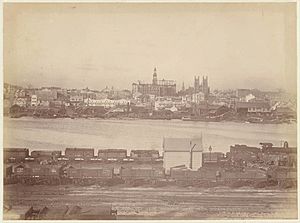
The idea for a freight terminal at Darling Harbour began way back in 1848. A railway line was built between the Sydney Railway Station (which is now Central railway station) and Darling Harbour. This line opened on September 26, 1855. At first, it mostly carried materials for building other railway lines. It also carried coke for steam engines and some timber. In the early years, the line didn't make much money from freight.
Over time, more goods started to be moved by train. By 1881, the main goods terminal in Sydney was getting too crowded. So, more freight traffic for Sydney was sent to Darling Harbour. The nearby Pyrmont Bridge was bought by the government, which made it easier for traders to use the railway. By 1891, all goods leaving Sydney were also sent from Darling Harbour.
By 1908, there was too much freight traffic on the lines to Darling Harbour. It was decided to build separate lines just for goods trains. These new lines would go from Sefton to Darling Harbour, passing through Enfield, Dulwich Hill, and Rozelle. There were also plans for extensions to Botany and the State Abattoirs (meat processing plants) at Homebush Bay. The line from Dulwich Hill to Darling Harbour was approved first. To avoid building a bridge next to the existing Glebe Island Bridge, a longer route was chosen around Rozelle Bay through Pyrmont. This plan included two tunnels under Pyrmont and Glebe. This new line opened on January 23, 1922.
Later, on October 14, 1925, a line opened from Marrickville to Port Botany. This was important for connecting the port to the rail network.
Changes to the Harbour Lines
The Darling Harbour railway line was used a lot in the early 1900s. However, as freight started to be moved in large containers, and new freight terminals opened in places like Chullora, Port Botany, and Port Kembla, less traffic went to Darling Harbour. The freight yards there closed in October 1984. In January 1996, the section of the line from Lilyfield to Central also closed.
Much of the old railway track area was later used for a new light rail system. This light rail opened to Wentworth Park in August 1997 and was extended to Lilyfield in August 2000.
A small part of the old line was kept near Central to connect the Powerhouse Museum to the network. A section of this line was later turned into a park and walking path called The Goods Line in August 2015.
In 1995, the freight network was expanded north. A special single freight line was built from Flemington to Homebush. This line then joined an existing line to North Strathfield and Rhodes.
During the 1990s, the section between Dulwich Hill and Rozelle also saw less train traffic. This was because grain was moved to Port Kembla, and the Enfield yard was updated. Also, the ports at Glebe Island and White Bay started to close down. The Rozelle yard became overgrown. Eventually, the only train service on this line was to deliver cereals to a flour mill. In 2009, the mill moved, and all train traffic on this line stopped.
In 2010, the NSW Government announced that the Inner West Light Rail would be extended along the old line from Lilyfield to Dulwich Hill. This extension opened on March 27, 2014.
The ARTC Takes Over
In August 2004, the Australian Rail Track Corporation (ARTC) and RailCorp made an agreement. The ARTC would lease, or rent, the Metropolitan Freight Network. This included the special freight lines in these areas:
- Sefton Park to Chullora
- Flemington South to Belmore
- Belmore to Marrickville (where freight and passenger trains shared tracks)
- Marrickville to Port Botany and Dulwich Hill to Rozelle
In August 2012, RailCorp leased the Metropolitan Goods line from Port Botany to Enfield to the ARTC for 50 years. This means ARTC will manage it for a very long time.
In January 2013, the ARTC opened the Southern Sydney Freight Line. This was a big extension to the dedicated freight network. It goes from the end of the Metropolitan Goods line at Sefton all the way to Macarthur.
The loop line between North Strathfield and Rhodes has been upgraded. It now has two tracks and an underpass. This was part of the Northern Sydney Freight Corridor project. The underpass opened in June 2015.


